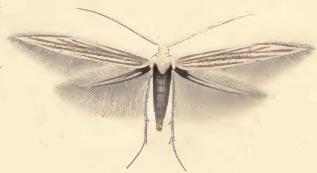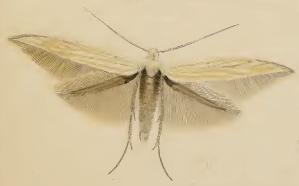
Comptonia peregrina is a species of flowering plant in the family Myricaceae native to eastern North America. It is the only extant (living) species in the genus Comptonia, although a number of extinct species are placed in the genus.

The Coleophoridae are a family of small moths, belonging to the huge superfamily Gelechioidea. Collectively known as case-bearers, casebearing moths or case moths, this family is represented on all continents, but the majority are found in temperate areas of the Northern Hemisphere. They are most common in the Palearctic, and rare in sub-Saharan Africa, South America, and Australia; consequently, they probably originated in northern Eurasia. They are relatively common in houses, they seek out moist areas to rest and procreate.

Coleophora is a very large genus of moths of the family Coleophoridae. It contains some 1,350 described species. The genus is represented on all continents, but the majority are found in the Nearctic and Palaearctic regions. Many authors have tried splitting the genus into numerous smaller ones, but most of these have not become widely accepted.

Coleophora serratella is a moth of the family Coleophoridae. It is found in Europe, Japan (Hokkaido) and North America.
Coleophora coracipennella is a moth of the family Coleophoridae. The species is found in Europe and was first described by Jacob Hübner in 1796.

Coleophora alnifoliae, the brown alder case-bearer, is a moth of the family Coleophoridae. C. alnifoliae is found in Europe, from Fennoscandia to the Pyrenees, Sardinia, Italy, Romania, Great Britain, Baltic States, Poland and North America. In Great Britain, its has been slowly expanding its range with scattered colonies in Southern England.

Coleophora limosipennella is a moth of the family Coleophoridae described by Philogène Auguste Joseph Duponchel in 1843. It is found in Europe from Fennoscandia to the Pyrenees, Italy and the Balkan Peninsula and from Great Britain to the Baltic States and Romania. It is an introduced species in North America.

Coleophora vestianella is a moth of the family Coleophoridae. It is found from Europe to Asia Minor, Iran, Afghanistan, China, the Korean Peninsula and Japan.

Coleophora ibipennella is a moth of the case-bearer family (Coleophoridae). It was first described by Philipp Christoph Zeller in 1849 and is found in Asia, Europe and North Africa. The larva feed within a pistol case on oak leaves and in the past was confused with Coleophora betulella, whose larva feed from a similar looking pistol case on birch leaves.

The metallic coleophora moth is a moth of the family Coleophoridae. It is native to Europe and Armenia, but is an adventive species in the Nearctic realm, where it is found throughout the United States and southern Canada. It has also been recorded from New Zealand, Chile and Argentina.
Coleophora adelogrammella is a moth of the family Coleophoridae. It is found from Fennoscandia to the Iberian Peninsula, Corsica, Italy, North Macedonia and Thrace and from France to Hungary.
Coleophora scabrida is a moth of the family Coleophoridae. It is found from Sweden to Spain and Italy and from France to southern Russia.

Coleophora colutella is a moth of the family Coleophoridae. It is found in all of Europe, except Great Britain and Ireland. It is an introduced species in North America.

Coleophora ledi is a moth of the family Coleophoridae. It is found from Fennoscandia and northern Russia to the Pyrenees and the Alps. In the east, it ranges to Japan. Outside of Eurasia, it is known from North America where it is found in eastern Canada, Michigan, and Alaska.

Coleophora millefolii is a moth of the family Coleophoridae. It is found in most of Europe, except Great Britain, Ireland and the Iberian Peninsula.

Coleophora partitella is a moth of the family Coleophoridae. It is found from Fennoscandia and to the Iberian Peninsula, Italy and Romania and from France to Poland.

Coleophora gallipennella is a moth of the family Coleophoridae. It is found in most of Europe. It is also found in Asia Minor.

Coleophora silenella is a moth of the family Coleophoridae. It is found in most of Europe, except Fennoscandia, Ireland, Greece, Portugal and Ukraine.

Coleophora cratipennella, the streaked coleophora moth, is a moth of the family Coleophoridae. It is found in the United States, including Kentucky, Pennsylvania, California, Maine and Oklahoma.
Acrobasis comptoniella, the sweetfern leaf casebearer or sweet-fern moth, is a species of snout moth in the subfamily Phycitinae. It was described by George Duryea Hulst in 1890 and is known from eastern Canada and the United States.










